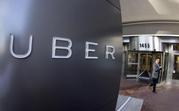- California Assembly OKs highest minimum wage in nation
- S. Korea unveils first graphic cigarette warnings
- US joins with South Korea, Japan in bid to deter North Korea
- LPGA golfer Chun In-gee finally back in action
- S. Korea won’t be top seed in final World Cup qualification round
- US men’s soccer misses 2nd straight Olympics
- US back on track in qualifying with 4-0 win over Guatemala
- High-intensity workout injuries spawn cottage industry
- CDC expands range of Zika mosquitoes into parts of Northeast
- Who knew? ‘The Walking Dead’ is helping families connect
UBER TO OFFER RIDES IN SELF-DRIVING CARS IN PITTSBURGH
SAN FRANCISCO (AP) — The option to hail a ride in a self-driving car, which was science fiction just a few years ago, will soon be available to Uber users in Pittsburgh, the first time the technology has been offered to the general public. 
Within weeks, the company announced Thursday, customers will be able to opt into a test program and summon an autonomous Ford Fusion. But since the technology has not been perfected, the cars will come with human backup drivers to handle any unexpected situations.
Although other companies including Google are testing self-driving cars on public roads, none offers rides to regular people. As an enticement, the autonomous rides will be free, the company said.
Uber, which has a self-driving research lab in Pittsburgh, has no immediate plans to deploy autonomous cars in other cities. But in an interview with The Associated Press, CEO Travis Kalanick said development of the vehicles is paramount for the San Francisco company, which has grown exponentially after starting seven years ago.
“We’ve got to be laser-focused on getting this to market, because it’s not a side project for us,” he said. “This is everything. This is all the marbles for Uber.”
Without drivers, the cost of hailing a ride will be cheaper than owning a car, changing the way we all get around, Kalanick has said.
By using human backup drivers, Uber is basically testing the technology and taking people along for the ride, said Bryant Walker Smith, a University of South Carolina professor who studies self-driving technology.
“Part of this is marketing in the sense that they’re going to be doing continued research and development of these systems,” he said.
Uber also announced that it was acquiring a startup called Otto that has focused on developing self-driving big rigs and is stocked with big talent in the still-small world of self-driving technology. Kalanick said the acquisition signals Uber’s intent to get into the movement of goods and freight.
In another deal, the company announced a $300 million alliance with Volvo to supply vehicles and technology. The announcements may push it ahead of its prime competitor, Lyft, which earlier this year took a $500 million investment from General Motors.
Those arrangements are among of a flurry of deals between Silicon Valley tech companies, traditional automakers and ride-hailing companies as they vie for autonomous car leadership. Google has been testing self-driving cars on public roads since 2009 but has never offered large-scale rides to the public.
Uber’s move to haul passengers with autonomous vehicles is not surprising, given the company’s history of pushing into gray areas with little or no regulation, Walker Smith said.
Local laws in Pittsburgh may require a driver behind the wheel, but Pennsylvania has no laws governing autonomous cars and their role in ride-hailing, he said.
He predicted that drivers will often have to intervene in Pittsburgh, with its winding, hilly roads and vast number of bridges. Each winter the city gets about 30 inches of snow, which can cover lane lines and trick autonomous car sensors that use them to help guide the ride.
Use of the backup drivers is also an acknowledgement that current autonomous driving systems cannot handle the wide range of unpredictable circumstances on public roads.
Timothy Carone, a Notre Dame professor and author of “Future Automation: Changes to Lives and to Businesses,” said Uber is trying to gain an advantage by putting its cars on the road before competitors. But unlike Tesla Motors, which put semi-autonomous technology in the hands of individual customers, Uber is mitigating the risk with its own drivers.
“This is a way to get autonomous cars out there and accepted and increase the adoption rate,” Carone said. “It will take a decade of testing before an 18-year-old can get in the car and tell it where to go.”
Kalanick would not speculate on when Uber might be ready to dispense with the human driver, saying that full automation can only be used now in limited places with little traffic. That’s different from the relative chaos of even a small downtown, much less a big city where drivers do not always follow the rules.
Carone expects Uber competitors will now accelerate self-driving tests or merger plans. He thinks they will adopt the same risk-management approach as Uber. Ford Motor Co., for example, said earlier this week that it will have a fully autonomous car with no steering wheel or pedals on the road by 2021, but it will only be used by car-sharing services and will not be sold to individuals.
Though the Google car project just lost its director, Chris Urmson, it has a big head start on Uber and others. Its leaders have suggested they could launch public pilot tests of cars with no steering wheels or pedals in the next year or two.
Volvo will provide Uber with SUVs for autonomous vehicle research. Eventually the SUVs will be part of the self-driving fleet in Pittsburgh. Both companies will design autonomous vehicles on their own.
The real breakthrough for autonomous cars, Walker Smith said, will be when a company puts one on public roads without a backup human. For now, like a motorcycle canyon jumper with a safety net, Uber isn’t ready to take the big leap.
“It’s probably for the best,” he said.











